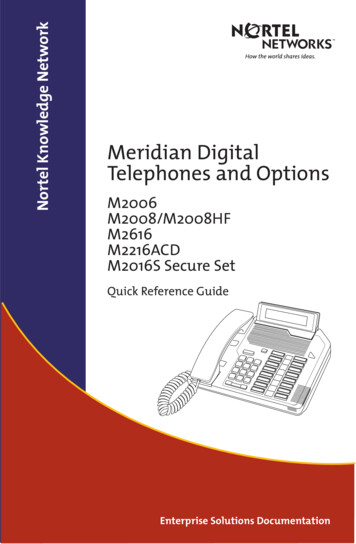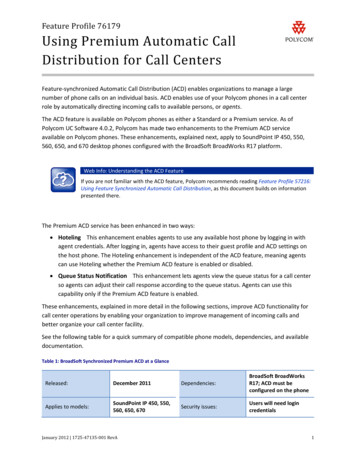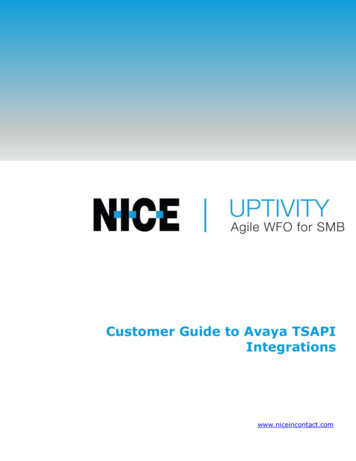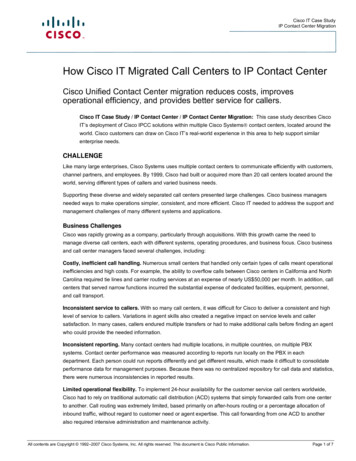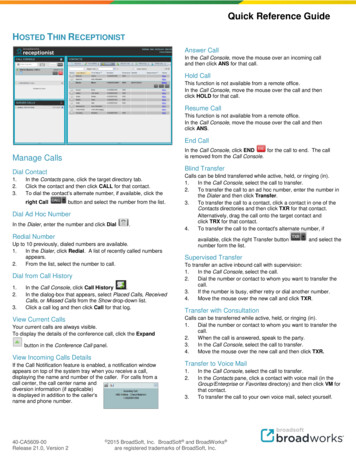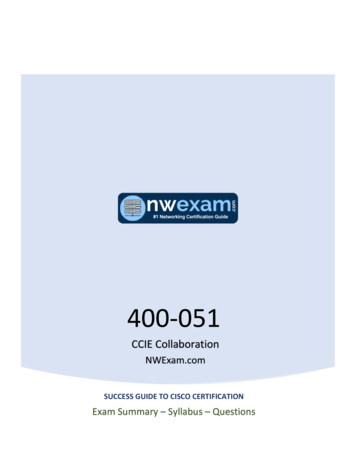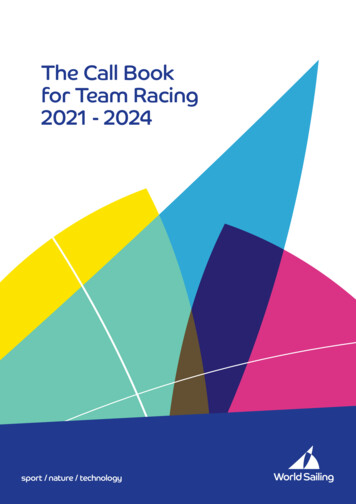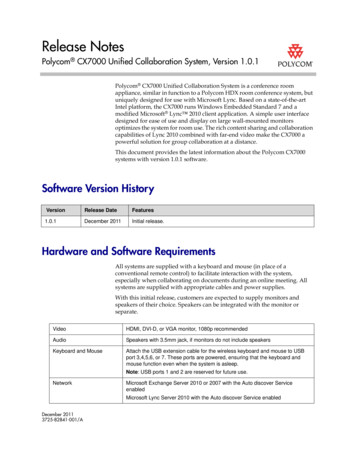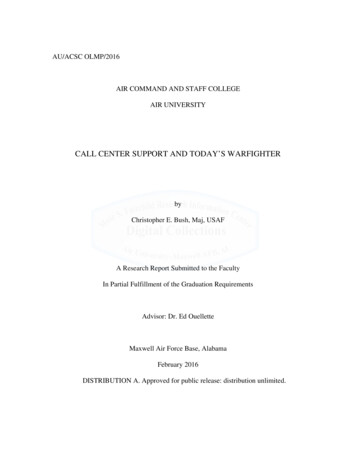
Transcription
AU/ACSC OLMP/2016AIR COMMAND AND STAFF COLLEGEAIR UNIVERSITYCALL CENTER SUPPORT AND TODAY’S WARFIGHTERbyChristopher E. Bush, Maj, USAFA Research Report Submitted to the FacultyIn Partial Fulfillment of the Graduation RequirementsAdvisor: Dr. Ed OuelletteMaxwell Air Force Base, AlabamaFebruary 2016DISTRIBUTION A. Approved for public release: distribution unlimited.
DisclaimerThe views expressed in this academic research paper are those of the author and donot reflect the official policy or position of the US government or the Department ofDefense. In accordance with Air Force Instruction 51-303, it is not copyrighted, but is theproperty of the United States government.ii
TABLE OF CONTENTSTABLE OF CONTENTS. iiiFIGURES . ivPREFACE . vABSTRACT. viINTRODUCTION . 1BACKGROUND . 4The Total Force Service Center (TFSC) . 4Not Just a Call Center. 6THREE COMPARISONS WITH INDUSTRY STANDARD . 9Contractor Relationships . 10Call Center Metrics . 13Culture and Environment . 19ANALYZING CALL CENTER OPERATIONS . 22Performance Based Contracts . 22Operational Flexibility . 22Impact to the Customer . 23RECOMMENDATIONS . 25CONCLUSION . 27NOTES . 28BIBLIOGRAPHY . .30iii
FIGURESFigure 1: TFSC Organizational Alignment .4Figure 2: AFPC Shared Service Delivery Model .6Figure 3: Figure 3. New AFPC Structure 7Figure 4: COR and Contractor Relationship .12Figure 5: TFSC Customer Satisfaction Survey and Product Delivery Increase 14Figure 6: TFSC CSR Quality Monitoring Form and Service Delivery Increase .15Figure 7: Effects of Balanced Metrics .17iv
PREFACEThe effort it took to write this thesis was—as it should be—a laborious process.Keeping that in mind, there is no way I could have even imagined completing this projectwithout the love and support of my wife. She selflessly picked up the slack, andcontinued to be the foundation of our household. Beyond that she is an incredible motherto our boys, and we’re incredibly thankful to have you in our lives. I could not have doneit without you. Thank you!I would also like to thank my assistant research advisor Mr. Craig Mills for hishelp shaping and refining this paper. Your constant guidance, encouragement andfriendship throughout this process was comforting and made the task at hand significantlyless daunting. Additionally, I also extend a debt of gratitude to Mrs. Suzie Clay, whoseperpetual review helped prevent this paper from being technically insufficient andgrammatically incorrect. I appreciate your patience!Finally, I extend my sincerest appreciation to all my fellow classmates. Youruntiring efforts and perpetual support helped refine and produce this final product – aproduct for which I am proud. I wish you well in your future endeavors, Godspeed!v
ABSTRACTOver the last decade, the way in which warfighters receive support has changeddramatically. Gone are the days when base-level personnel offices had the autonomy toresolve, update, and provide face-to-face customer service with their servicingpopulations. Instead, the AF, due to budget constraints, has centralized all personnelsupport at the Air Force Personnel Center (AFPC). This action has resulted in anincreased footprint of a fully contracted call center function, known as the Total ForceService Center (TFSC). As a result of this growing concept and function for the AirForce, many lessons learned potentially exist within private industry. This paper asks thequestion “What best practices can the TFSC adopt to provide higher levels of service andincreased customer satisfaction?” During development, this paper will employ a mixedmethod research methodology, specifically a comparative case study analysis of bothcompanies coupled with an examination of published reports and technical papers. Bycomparing two organizational constructs, coupled with legitimate “hands-on” experiencerelating to each company’s customer call center operations, a better understanding as towhether shortfalls exist within the TFSC.vi
INTRODUCTIONThe landscape of customer service delivery is rapidly changing throughout theDepartment of Defense (DoD). Military organizations once teeming with robust support staffshave now been reduced to little, if any, personnel to provide customer service at the tacticallevel. One of the main reasons for such a dynamic change is due in large part to an overalldecrease in government spending and a downward trending DoD budget. 1 This forced Air Forcefunctional managers to draw a hard line as to what was important and, if retained, how to providecontinued service to the warfighter. One of those decisions inevitably marked the inception ofthe Total Force Service Center (TFSC) at Randolph Air Force Base, San Antonio, Texas.The Total Force Service Center, by today’s standards, is the DoD’s version of a customercall center, and is the single point of contact for all Air Force Active Duty members stationedworld-wide. In addition to serving roughly 393,000 customers annually, personnel within theTFSC advise members on myriad actions, ranging from updating duty histories to processingseparation orders. 2 Fortunately, the consolidation of such a large function garnered spendingefficiencies. Unfortunately, it came at the expense of the warfighter. The function that once wasprovided by the wing personnel office, an office that provided timely, local management, is nowan enterprise function with little to no quality customer service. In addition, by removing thelocal personnel authorities, Air Force members began to see an increase in inaccurateinformation regarding policy interpretation and general guidance regarding personnel solutions. 3Fortunately for the Air Force and the TFSC, the private industry, particularly large diverseinsurance firms, thrives on the capable functionality provided by their customer contact center.Often times the “call center” for each of these firms provides the daily interaction between senior1
executives and the customer. Of course, some companies provide this service better than others,but still best practices exist that may provide suitable solutions for the TFSC and its customerpopulation.This paper proposes that private industry customer contact centers provide processimprovement opportunities for the TFSC. In addition, it will answer the question, “What bestpractices can the TFSC adopt to provide higher levels of service and increased customersatisfaction?” For the purpose of this paper, the private industry partner that was chosen forcomparison was a diversified financial services firm serving the US military, and for proprietaryreasons, the name of the company will be kept generic and will not be specified. In addition toservicing a similar customer base, this company is perpetually in the top half of Fortune 500companies among customer satisfaction, and have fostered their approach so as to be constantlyin-tune with over 11 million customer demands. 4 As a result, this paper maintains that the TFSCcan learn from these private industry leaders, and improve the current level of service provided.This paper will employ a mixed method research methodology, specifically acomparative case study analysis of both companies coupled with an examination of publishedreports and technical papers. The intent of partnering two research frameworks is to comparedocumented organizational constructs, accolades and metrics with legitimate “hands-on”experience relating to each company’s customer call center operations. In addition, theexamination of technical papers and published reports will foster the discussion of past andpresent organizational structures, as well as the shift in customer support provided by bothprivate and federal organizations. These sources are not only relevant, but important inunderstanding the strategic vision of both organizations, as well as highlighting common guidingprinciples. In addition to published research, interviews with both organizations will be2
conducted to round out the qualitative analysis of both company operations. This will result intwo independent case studies, measuring the culture and environment, call center metrics andcontractor relationships and how they interrelate. Completing these case studies will hopefullyhighlight similarities but accentuate the disparities the TFSC may have from an organizationalapproach. The goal, as mentioned, is to provide suitable results for the TFSC to adopt, thusproviding a better product to Air Force member’s world-wide.3
BACKGROUNDThe Total Force Service Center (TFSC)The TFSC is functionally aligned under the Air Force Personnel Center at Joint Base SanAntonio (JBSA) Randolph in San Antonio, Texas. It was originally the Total Force Call Center,but was aptly renamed to the TFSC because their mission set dictated more than just call centeroperations. In today’s organizational structure, the TFSC is located in the Operations SupportBranch, DP1OS, which is organizationally aligned within the Operations Support and RecordsManagement Division, DP1O (Figure 1). 5Figure 1: TFSC Organizational Alignment 6Historically, the TFSC was started solely to provide contract surveillance for evaluationsand discharge paperwork (DD214s). They were also chartered to report numbers, but providelittle to no analysis of personnel programs. As a result, the TFSC encountered a multitude ofproblems to include manning shortages, increased processing errors and dissatisfied customers.In order to mitigate these issues and become more proactive to customer demand, senior leadersdecided to combine manning from the transition and sustainment directorates to help with4
customer workload and build a collaborative environment across each branch. 7 By doing so, aworkload that was typically done in segmented directorates, is now compiled into a single workcenter function, now located in DP1O. This change was due in large part to AFPC reorganizinginto a new matrix organization to better meet customer demand through a four-tiered approach,Tiers 0-3.The lowest level, tier 0, consists of self-help applications and systems. 8 An exampleincludes on-line system functionality that allows you to manage your own products providedthrough an Information Technology (IT) platform. It is typically available 24 hours, 7 days aweek and 365 days a year, and requires little, if any, face-to-face interaction. Despite tier 0being the foundation for AFPC’s shared services delivery to the customer, it varies slightly fromtier 1.Tier 1, unlike tier 0, consist of mappable, repeatable, transactional work. 9 Although stilldependent on an IT platform, Customer Service Representative (CSR) interaction increaseswithin this tier by performing simple, repeatable tasks. An example of work found within thistier includes awards and decorations processing. Although basic and not incredibly dynamic,both of these tiers present a standardized form of customer service. This varies greatly whenentering Tier 2.Tier 2 is the most dynamic of the 4 tier levels. It consists of work that requires subjectmatter expertise and the black and white becomes more grey, regarding policy interpretation.This tier leverages personal experience garnered from training classes and experience in thefield. 10 It is also the tier that presents the most frustration stemming from customer questions anddemand. Although vast, an example of work found in this tier includes referral performancereports and administrative actions. As a result of the broadening scope, Tiers 2 (and 3) have an5
increased dialogue regarding policy interpretation and customer delivery. However, the onlydifference is that Tier 3, the functional process owners, do not interact with the customers.Instead, they foster communication up and down the chain of command, regarding policydevelopment and interpretation. This is done at the local level or with Headquarters Air Force(HAF), located at the Pentagon. Figure 2, AFPC‘s Shared Services Delivery Model, highlightsthe relationship across the directorates, via the functional managers found in DP3, and thecustomer service provided in DPO, DP1 and DP2.Figure 2: AFPC Shared Services Delivery Model 11Not Just a Call CenterComplexities exist in most organizations, and AFPC is no exception. It is not only theexecution arm for all Air Force personnel programs, but the reach-back capability for all AFmembers deployed throughout the world. In addition to personnel programs, AFPC is also theauthority for AF casualty reporting. For example, if an AF active duty member is involved in anautomobile accident and they are transported to the hospital for accident related injuries,AFPC/DPFA, Casualty and Mortuary Affairs Division, will update and up-channel the medical6
prognosis through the AFPC Commander to HAF until the member is fully recovered or themember is declared deceased. Despite events as highlighted, casualty and mortuary affairs arenot the only additional function within AFPC. DPF, Directorate for Airman and Family Care, isalso chartered with providing care to Wounded Warriors via the Disability Division, located inDPFD and DPFW, as well as Airman and their families in DPFF.However, most external customers still believe AFPC is just a call center. It is, quitesimply, an operation perpetually stove-piped with functional limitations rarely extending beyonda call center providing customer support to only active duty members and active duty programs.Understanding the public optic is not only paramount, it is justified. Most AF members havevery little interaction with DP2, 3, and 4, but are intimately familiar with DP1, despite it being asliver of the AFPC organization. As a result, it is important to focus on this operation to betterunderstand the services provided and streamline delivery to capture customer needs.Figure 3. New AFPC structure7
As mentioned, the TFSC, located within DP1OS, is embedded within the DP1O division.The DP1O division is one of three divisions of the DP1, Total Force Service Center - SADirectorate. The DP1 directorate is one of five directorates that make up AFPC. 12 As previouslydiscussed, DP1OS, despite being a small function within AFPC, has truly a global impact.Breaking it down even further, the TFSC provides much more than just Customer ServiceRepresentatives. It also provides Quality Assurance (QA), both military and civilian, aimed atproviding innovative solutions for future incorporation into new personnel processes onceapproved by DP1 leadership. An example of this is the future development of a commonoperating platform between service centers. What this is aimed to provide is a broadened serviceplatform aimed at increasing the workforce management capability and support up to 1,100concurrent phone calls at any given time - in other words, opening the valve to increase thecustomer call volume demand.Additional responsibilities of the TFSC include personnel records management, fieldactivity webcast for AF programs implementation, and personnel IT systems support. 13 DP1 hasa total of 420 personnel (military/civilian/Contract Military Equivalents or CME’s), 36 percentof which belong to the TFSC (151 personnel). 14 In other words, a third of one directorate, in anAFPC that consists of only five directorates, provides call center Tier 1 support to approximately320,000 customers. 15 To better understand the magnitude of service in such a small function, theannual breakouts from calendar year 2014 include 452,000 calls offered, 393,000 calls handled,39,020 Email Us Inquiries, 12,985 live chats, and 40,750 DD 214 resolutions.How does this compare to the private industry? In the next chapter, a comparison toindustry standard will be made with respect to contractor relationships, call center functionalityand metric comparison, and overall culture and environment.8
THREE COMPARISONS WITH INDUSTRY STANDARDThe contact center industry is still in its infancy, with the most mature not exceeding aquarter century. 16 However, their presence is becoming ever more relevant within most privateindustry corporations. It has been said that the companies that succeed in the 21st century willbe those that learn how to strategically integrate the contact center into the rest of theorganization. 17 However, learning how to successfully integrate a call center and providesuitable customer service is the single greatest component. This action, or lack thereof, not onlydictates the company’s ability to provide a service, but establishes a better optic for the customerto decide whether to stay with a certain company long-term.In the case of the TFSC, the customer base remains fairly static. It is a call centeroperation providing an organic service with zero market competition. However, this does notmean suitable customer service should not exist. Instead, with the inception of such a specializedservice to a specialized population, opportunities for improvement exist unlike those in privateindustry. In other words, the TFSC has to continue to develop to meet the needs of the Secretaryof the Air Force (SECAF) and the Chief of Staff of the Air Force (CSAF). A few recentexamples include static close-out dates for all Technical Sergeant performance evaluations orleave accrual balances reducing to no more than 60 days of leave held over a 365-day period,excluding deployments. Unfortunately for the TFSC, all of these programs are downward driventhrough policy, with accelerated timelines for implementation. Very little of what the TFSCchanges regarding service is dictated by the customer – bottom up feedback. As a result, this canput a significant strain on the TFSC and their operation to meet the customer demand and stillprovide service driven by senior leader policy.Many factors play into the success of call centers, a few of these to be examined include9
contractor relationships, certain call center metrics and the overall culture and environment ofeach organization. These comparisons will provide the opportunity to delineate best practicesfrom private industry for implementation within the TFSC. However, before recommendationscan be made, let us examine the relationship between private industry and the TFSC and examinetheir respective contracts.Contractor RelationshipsAs one would expect, many organizations use contracts to outsource some level of workthat is required for day-to-day operations. It is the cost of doing business. Often times, mostexecutives within a company have to determine if their current manning levels can perform thework required. If companies cannot, or if the determination is made that it can be done at alesser cost, then a contract is awarded. Unfortunately, myriad questions exist when an outsidesource does business on behalf of an organization. Questions, such as: Is the contractor aseparate entity or does he become part of the team? How do the employees relate to thecontractor? et al. The fact remains that a customer expects a service, regardless of how it isprovided.As part of the contractor relationship, it is important for the company to clearly define theduties associated with awarding a contract. When the industry completely outsources a givenduty, they lose a tremendous amount of control over the execution of that responsibility. Anexample of this includes updating call center scripts to standardize the dialogue between thecompany and the customer. If consistent negative customer feedback is received regardingcustomer interaction, then the contracting organization has to coordinate with the contract lead tomodify all CSR literature. This action could take time, in turn negatively impacting the overallbottom line. In an effort to always retain control, very little of what most private companies10
outsource involves frontline interaction with the customer base. Instead, private industry oftenpossesses this frontline interaction in-house, to afford maximum control over customerperception and industry communication. 18 If a contract is awarded by private industry, the workconducted is considered basic, and would include requesting customers to validate personalinformation on-file.Still, some level of trust is given and successful endeavors rarely stray from ensuring thatthe contractor does not feel like a part of the team. Instead, when flawlessly executed, customershave a difficult time making the distinction between the contractor and the organization. In otherwords, who and how the service is being provided should be invisible to the external customer.Another critical component of the contractor relationship is the contract administration. Contractsare formal legal agreements that specify the services the contractor has been hired to perform onbehalf of the company. What and how they will provide it is often detailed in Performance WorkStatements (PWS), which can vary greatly in length depending on the services requested and fromcompany to company. In addition, a Contracting Office Representative (COR), or industryequivalent, is appointed to ensure that the contractor is adhering to the contract and providing theservice for which they were hired. This relationship between the COR and Contractor Site lead isvitally important to the success of the contract. As depicted in Figure 4, the most successfulcontracts involve lenient COR’s and responsive contractors mainly because the COR givesadequate space for the lead contractor to make adjustments to customer demand or organizationalinput. On the other hand, the most detrimental contracting relationship also involves a lenientCOR but includes an unresponsive contractor. This situation lacks accountability from the CORand incorporates a contracting site lead disassociated from customer demand or contract delivery.11
Figure 4. COR and Contractor RelationshipPrivate industries’ approach to contract relationships generally fall within the greencategory mainly because all industry COR equivalents up-channel vital information directly tothe unit they support. In other words, these supported units work directly with the contract ontactical priorities and evaluation measures. As a result, the responsive contracting site lead canmake real-time adjustments without going back through a contracting officer every time. This isafforded by the flexible environment fabricated within the confines of the contract and executedby the COR. Outputs generated by this approach avoid tarnishing the COR and contractorrelationship and produce an optimal product to the customer. 19AFPC, on the other hand, has contracted all of the TFSC call center operations withinDP1OS. The contract currently in place was awarded to Lockheed-Martin (L-M) in 2005, andwas established as a performance-based contract. 20 Additionally, all of the contractors within theTFSC are physically located within AFPC, and COR responsibilities exist with the QualityAssurance shop, also located within DP1OS. 21 Over the tenure of the contract, a symbioticrelationship has evolved between the COR and the contracting site lead. Despite positive trends12
in rolling Fourth quarter customer service satisfaction surveys, problems still persist primarilywith increased errors and dissatisfied customers. 22 One solution recommended by the COR tothe site lead to decrease CSR errors was to increase training and standardize call center scripts toadjusting AF policy. Despite being vocalized by the COR, no adjustments were made by thecontractor. Part of the reason for the stationary approach by L-M was that the PWS specified thecontract was performance-based and not based on customer satisfaction. As a result, despiteowning the contract and awarding it to L-M, adjusting the contract would initiate additionalfunds allocation, a cost the AF is not willing to accept. By virtue of this contract relationshipreview the classification of this relationship would be yellow. It is clear that the COR is beingstrict and operating within the confines of the PWS, but the contractor is clearly beingunresponsive.In summary, it is evident that the private industry understands the value of control,especially in regard to customer service. It is also evident that the TFSC is willing to accept thisshortfall, until it has adequate funds to modify the PWS or wait until the contract gets renewed.Call Center MetricsMany different performance measurements are used to gauge the efficiency andeffectiveness of a call center operation. 23 Some of these measures are for overall call centerperformance; others focus on the individual employee. The main purpose of these performancemeasures is to ensure the call center is meeting its goals and objectives and that all personnel areachieving their work potential. 24 Additionally, these key performance indicators vary fromoperation to operation, and from company to company. For example, one company may focuson the abandoned call rate for their call center while another focuses purely on hours of operation13
and the company’s self-service applicability. Even though companies differ in their choices ofwhich industry measurements are important, companies that successfully integrate these businessmeasures understand they need to remain adaptive, and balanced, without placing punitivemeasures alongside certain measurement indicators.One example of a business practice adapted to work center measures and customer valueincludes the TFSC and its CSR service delivery. As mentioned in the previous chapter, the TFSCcontract is performance-based. The primary focus of L-M is on production and throughput,despite CSR delivery. Unfortunately for the customer that did not result in adequate customerservice. As a result, Quality Assurance (QA) within DPSO1 decided that product delivery wasimportant to overall customer satisfaction. In response, QA initiated two forms, pictured infigures 5 and 6, which focused on CSR interaction and customer feedback. 25 The intent wassimple. It was an attempt to partner an increase in service, as expected via the PWS, and improveoverall customer interaction.Figure 5: TFSC Customer Satisfaction Survey and Product Delivery Increase 2614
The primary focus of the TFSC Customer Satisfaction Survey, was to acquire customerfeedback. This process afforded customers an opportunity to fill out a form provided by theTFSC, depicted in the background of Figure 5, and rate the level of service they were providedby the CSR on a 5-point scale. Once completed and returned to DPSO1, data was compiled forthe month and used to determine trends or CSR performance. As expected, customer satisfactionhas projected upward since its inception 1 June 2015. 27 This initiative validates that adjusting tofeedback vocalized by the field, coupled with process improvement initiatives by the TFSC, hasincreased overall customer service.Figure 6. TFSC CSR Quality Monitoring Form and Service Delivery Increase 28Similar in concept to the TFSC Customer Satisfaction Survey, the TFSC CSR QualityMonitoring Form was the second form implemented to adjust and provide better overall15
customer service. However, unlike the customer satisfaction survey, this was an internal measurefabricated by the QA shop within DPSO1 to “listen in” to conversations between a CSR and thecustomer. The overall intent was to focus more attention on delivery and provide feedback toCSR representatives and encourage training of L-M contractors if the delivery intent was notmet. As seen in the customer satisfaction survey, upward positive trends in service levelsurfaced since its inception 1 June 2015. 29 Additionally, this information helped socializedelivery techniques with CSR representatives and helped focus on the interaction between themand the customer. This not only resulted in an overall service level increase of CSR agents butalso increased the positive feedback provided by the TFSC customers (Figure 6).As mentioned, if work center measures are not adaptable and deliver direct insight intooperations, they have little worth. Instead, i
support at the Air Force Personnel Center (AFPC). This action has resulted in an increased footprint of a fully contracted call center function, known as the Total Force Service Center (TFSC). As a result of this growing concept and function for the Air Force, many lessons learned potentially exist within private industry. This paper asks the
